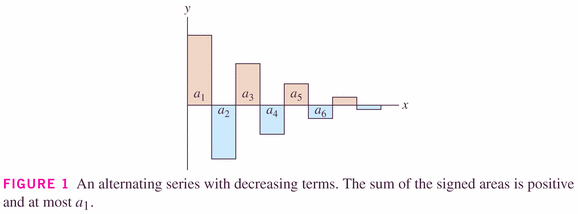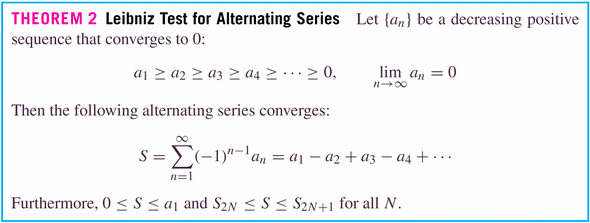- Sorry: I didn't get your homework 11.3 graded yet. I'll hope to have it tomorrow.
- Your homework for 11.4 is due tomorrow.
- There will be a quiz opportunity tomorrow. It will be over 11.8 (that's right, skipping 11.7, which is a summary of what we've learned so far about convergence of series). Please read ahead!
-
Once again, our mission here is not necessarily the value of the
series, but may be simply knowledge of whether it converges or
not.
- Examples:
- The alternating harmonic series is convergent (Example 1, p. 753).
- #5, p. 755
- #13
- #17
- #23
- #27
- #34
That being said, Theorem 2 below does give us some help in determining the value of (or at least bounds on the value of) the series of a type called an "alternating" series.


- First, a definition:

- Series that converge absolutely, and
- Series that don't.


- Examples:
- #5, p. 761
- #12, p. 761
- It turns out that conditionally convergent series can have their terms rearranged to converge to any limit you like (see "Rearrangements", on p. 761). Hmmm.... Is this the end of commutativity?!
- The Ratio and Root Tests
- There are two main tests for convergence of series in this section:

This result says that eventually the ratio of successive terms is effectively constant,
: the terms of the sequence approach a "common ratio" as
. What kind of series looks like that? A geometric series:
Examples:
- #2, p. 761
- #3, p. 761
One difference between the ratio test and the root test is that the ratio test is a self-referrential comparison test: we compare terms of
with other terms
(rather than with some other series).

This result says that eventually the absolute values of the terms are effectively equal to
: what kind of series looks like that? A geometric series!
No wonder the results of the tests look exactly the same.... Too bad Rogawski didn't just use the same letter for the limits in both cases!
Notice that, once again, limits of sequences plays an important role! Series are just sums of sequences, after all; we're focused on how terms behave (root test), how successive terms behave (ratio test), or how partial sums behave.
Examples:
- #7, p. 761
- #13, p. 761
- There are two main tests for convergence of series in this section: